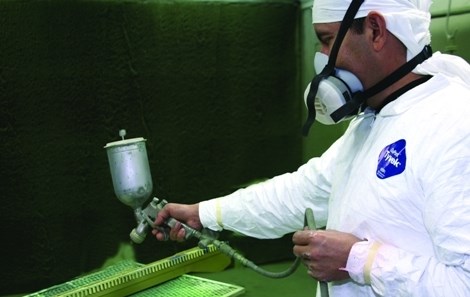California Ready to Add New VOC Rule
The American Coating Association and several Southern California metal coaters are battling the South Coast Air Quality Management District over proposed Rule 1107 that calls for lowering volatile organic compound emissions from the coating of metal parts and products. The proposed rule applies to metal coatings or companies that perform metal stripping operations, and to all manufacturers, distributors and suppliers of metal coatings.

The American Coating Association and several Southern California metal coaters are battling the South Coast Air Quality Management District over proposed Rule 1107 that calls for lowering volatile organic compound emissions from the coating of metal parts and products.
The proposed rule applies to metal coatings or companies that perform metal stripping operations, and to all manufacturers, distributors and suppliers of metal coatings.
At its last working group meeting, SCAQMD staff mentioned possibly lowering the following volatile organic compound (VOC) limits:
- General One-Component coatings from 275 g/L to 100 g/L
- General Multi-Component coatings from 340/275 g/L to 100 g/L
- Extreme High Gloss coatings from 420/360 g/L to 360 g/L
- Extreme Performance coatings from 420/360 g/L to 275 g/L
- Prefabricated Architectural One-Component from 275 g L to 100 g/L
- Prefabricated Architectural Multi-Component from 340/275 g/L to 100 g/L
- High Performance Architectural - eliminate category
Also of concern, SCAQMD is considering a "Prohibition of Sale" provision that would restrict the sale and distribution for use in the district any coating which, when applied as supplied or thinned or reduced according to the manufacturer's recommendation for application, does not meet the limits of the rule. Since many coatings can be used on various substrates, distributors and paint stores may find complying with this provision very difficult.
The SCAQMD is the air pollution control agency for all of Orange County and the urban portions of Los Angeles, Riverside and San Bernardino counties. This area of 10,743 square miles is home to over 16.8 million people - about half the population of the whole state of California. It is the second most populated urban area in the United States and one of the smoggiest.
The SCAQMD held a public hearing on June 15 in which several metal coaters attended and voiced objection to the rule. It wants to have the rules in place by September.
The ACA’s objections are:
General Prohibition: As with the Architectural and Industrial Maintenance (AIM Rule 1113), if adopted as written, SCAQMD inspectors will be able to pursue paint manufacturers, stores, and distributors if coatings intended for use on metal do not meet the applicable volatile organic compound (VOC) limit. What’s more, if this provision is adopted, it is very likely this provision will spread to other SCAQMD rules and across the United States.
100 g/l limit for General, High Gloss, Primer, and Prefabricated Architectural Categories: SCAQMD is assuming that Industrial Maintenance and Architectural and Industrial Maintenance primers can be effectively used on shop applied metal parts and products. Again, if these limits are adopted, they will likely propagate to similar rules across the United States.
Coatings for aerospace assembly, magnet wire, marine craft, motor vehicle, metal container, and coil coating operations would be exempted. Nor would the rule apply to architectural components coated at the structure site or at a temporary, unimproved location designated exclusively for that purpose.
Although the rule would apply only to Southern California, SCAQMD is highly influential and its rules are considered a bellwether for environmental policies nationwide.
The see how SCAQMD encourages reporting air quality problems, watch this video:
Related Content
Zinc Phosphate: Questions and Answers
Our experts share specific questions about zinc phosphate and pretreatment
Read MoreUltrafiltration Membranes, Filter Elements for Improved Industrial Water Reuse
Ultrafiltration membranes help with water reuse in a variety of applications.
Read MoreNASF/AESF Foundation Research Project #120: Electrochemical Destruction of Perfluorooctanesulfonate in Electroplating Wastewaters – January – December 2023
This NASF-AESF Foundation research project report covers quarterly reporting for the year 2023 at the University of Illinois at Chicago. The objective of this work is to utilize a cost-effective reactive electrochemical membrane (REM) for the removal of PFAS from synthetic electroplating wastewater. Discussed here are the oxidation of PFOA with three different catalysts, development of a method for detecting PFAS, as well as work on 6:2-fluorotelomersulfonic acid (6:2 FTS) and electrodeposited bismuth/tin oxide catalysts.
Read MoreNASF/AESF Foundation Research Project #120: Electrochemical Destruction of Perfluorooctanesulfonate in Electroplating Wastewaters - April 2022-March 2023
This NASF-AESF Foundation research project report covers project work from April 2022 to March 2023 at the University of Illinois at Chicago. The overall objective of this work is to utilize a cost-effective reactive electrochemical membrane (REM) for the removal of PFAS from synthetic electroplating wastewater. Initial results for the oxidation of PFOA with three different catalysts are discussed.
Read MoreRead Next
Delivering Increased Benefits to Greenhouse Films
Baystar's Borstar technology is helping customers deliver better, more reliable production methods to greenhouse agriculture.
Read MoreEpisode 45: An Interview with Chandler Mancuso, MacDermid Envio Solutions
Chandler Mancuso, technical director with MacDermid Envio discusses updating your wastewater treatment system and implementing materials recycling solutions to increase efficiencies, control costs and reduce environmental impact.
Read MoreA ‘Clean’ Agenda Offers Unique Presentations in Chicago
The 2024 Parts Cleaning Conference, co-located with the International Manufacturing Technology Show, includes presentations by several speakers who are new to the conference and topics that have not been covered in past editions of this event.
Read More













.jpg;maxWidth=300;quality=90)







